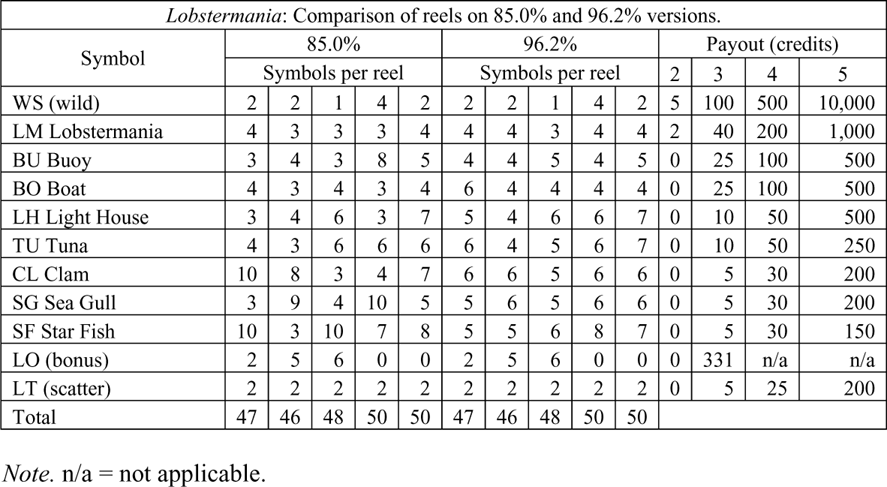- Everi Digital Expands Relationship with Parx Casino, Delivering Additional Player-Preferred Slot Content for Online Real-Money Play in New Jersey. Company Builds on Success of December 2019 Launch with Parx Online in Pennsylvania LAS VEGAS (August 10, 2020) – Everi Digital, the online gaming division of Everi Holdings Inc.
- Every slot machine at a casino uses something called a par sheet which provides information about the odds for each tile on a reel. Each reel is weighted to reach a certain number of spins for every time a certain tile is generated by the algorithm.
- Slot Machine Calculator. Estimates how much you might win or lose based on your slot machine and playing style. First, specify Bet Per Spin, your Play Pace, Return to Player (RTP)%, and Volatility level. Then click the Calculate button and see results in the table. If you later change one or more of these parameters, click the Calculate.
The distribution and arrangement of the symbols on each reel is also part of the configuration of a slot machine. On virtual slot machines and slot games in new slot sites, the physical configuration is replaced by parametric constraints upon the RNG (Random Number Generator). For the probability calculus in slots, only a part of the parameters. Every slot maker creates a 'par sheet' that lists the symbol frequency and the paytable. This allows the payback to be calculated, and a programmer to write the computer code. Slot manufacturers guard these par sheets religiously, for no good reason.
Saw lots of people playing this game, both NightLife and Diamonds variations.
out of curiosity, want to know what the various Return % settings are.
I’m not sure how you would go about that without having any contacts.
I have a feeling the 'secrets' (i.e. what you would find on a par sheet) to a slot machine are handled the same way.
Administrator
I think if you tipped a slot technician very well he might tell you what return any given game is set to. It's quite another matter to get the par sheet, which I don't know why a recreational player would want anyway.
how else could I get what the various Return % settings are?
maybe the par sheet isn't what I want?
Understanding Slot Machine Par Sheets
maybe the marketing summary sheet is what I need?Administrator

how else could I get what the various Return % settings are?
maybe the par sheet isn't what I want?
maybe the marketing summary sheet is what I need?
You just need the theoretical return. A slot technician would be able to get at that easily if he wanted to.
You just need the theoretical return. A slot technician would be able to get at that easily if he wanted to.
That's not always true. Sometimes casinos put the par sheet inside the machine, some don't. A regular slot tech wouldn't normally have access to the numbers if they are not in the machine. It would have to be a higher lever tech or Supervisor with access to the Slot Accounting System.
 Also, even if they do have access, not many would be willing to share that information and risk their job for $20 or $50. They would most likely be terminated with no warning if seen or found to be sharing that info.
Also, even if they do have access, not many would be willing to share that information and risk their job for $20 or $50. They would most likely be terminated with no warning if seen or found to be sharing that info.If it was that easy, par sheets would be all over the place.
ZCore13
https://www.sggaming.com/games/WMS/class3/VIDEO/Lock-It-Link-Night-Life-4060
Saw lots of people playing this game, both NightLife and Diamonds variations.
out of curiosity, want to know what the various Return % settings are.
On the Night Life game the marketing materials say there are five different pay schedules from 87% to 95%.
Slot Machine Par Sheet
As for legally finding a PAR sheet as a member of the general public with no relevant contacts, that happens either by complete accident or by someone's carelessness.
This article is available in: HTMLPDF
PAR Sheets, probabilities, and slot machine play: Implications for problem and non-problem gambling
Understanding Slot Machine Par Sheets
Abstract
Through the Freedom of Information and Protection of Privacy Act, we obtained design documents, called PAR Sheets, for slot machine games that are in use in Ontario, Canada. From our analysis of these PAR Sheets and observations from playing and watching others play these games, we report on the design of the structural characteristics of Ontario slots and their implications for problem gambling. We discuss characteristics such as speed of play, stop buttons, bonus modes, hand-pays, nudges, near misses, how some wins are in fact losses, and how two identical looking slot machines can have very different payback percentages. We then discuss how these characteristics can lead to multi-level reinforcement schedules (different reinforcement schedules for frequent and infrequent gamblers playing the same game) and how they may provide an illusion of control and contribute in other ways to irrational thinking, all of which are known risk factors for problem gambling.
Keywords
DOI: http://dx.doi.org/10.4309/jgi.2009.23.5
Copyright © 2020 Centre for Addiction and Mental Health
Editor-in-chief: Nigel E. Turner, Ph.D.
Managing Editor:Vivien Rekkas, Ph.D. (contact)